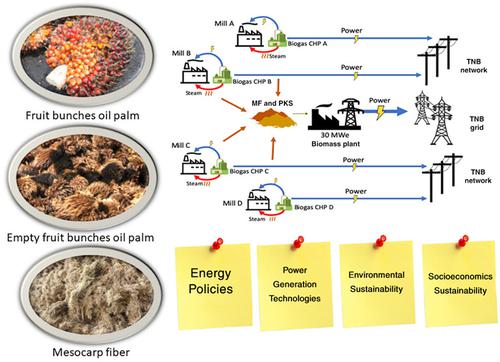概述棕榈油生物质发电部门脱碳在马来西亚:进展,挑战和前景
IF 5.4
3区 工程技术
Q2 ENERGY & FUELS
引用次数: 9
摘要
随着气候变化的危险日益加剧,发电厂正在从污染严重的化石燃料转向可持续的生物能源燃料。随着马来西亚继续承诺减少温室气体(GHG)的排放,迅速和戏剧性的行动应该解决对化石燃料发电厂的依赖。此外,该燃煤发电站是马来西亚最大的能源供应商,也是最后一个退役的发电厂。在马来西亚,棕榈油生物质的很大一部分有潜力取代煤炭生产可再生能源。然而,棕榈油生物质作为可再生能源的部署尚未完全实现。此外,棕榈油加工过程中未利用的生物质过剩已成为导致环境问题的关键话题。据估计,这种棕榈油生物质可以在40%的运行效率下产生大约5000兆瓦的电力。这种巨大的电力潜力有能力取代马来西亚每年对煤炭的依赖。然而,技术稳定性的限制、预算限制和其他政府政策问题阻碍了潜力的发挥。这就需要一个综合框架来协同脱碳驱动,以实现能源可再生和碳中和的主要优势。在建议的使发电部门脱碳的行动中,包括棕榈油生产、用于发电和蒸汽产生的沼气厂以及生物燃料颗粒制造的综合方案。这篇综述提供了棕榈油生物质对马来西亚电力生产脱碳的深入概述。本文章由计算机程序翻译,如有差异,请以英文原文为准。

An overview of palm oil biomass for power generation sector decarbonization in Malaysia: Progress, challenges, and prospects
With the ever‐increasing danger of climate change, power plants are shifting from polluting fossil fuels to sustainable bioenergy fuels. As Malaysia continues to pledge to decrease glasshouse gas (GHG) emissions, quick and dramatic action should resolve the reliance on fossil fuel power plants. Furthermore, the coal‐fired power station is Malaysia's biggest supplier of energy and the final power plant to be decommissioned. In Malaysia, a significant portion of palm oil biomass has the potential to replace coal in the generation of renewable energy power. However, the deployment of palm oil biomass as a renewable energy source has not been fully achieved. Furthermore, the surplus of unutilized biomass from the palm oil milling process has emerged as the key talking point leading to environmental concerns. As estimated, this palm oil biomass can generate approximately 5000 MW of electricity under 40% of operation efficiency. This significant power potential has the ability to replace Malaysia's yearly reliance on coal. Nonetheless, the limitations of technological stability, budgetary constraints, and other government policy concerns have prevented the potentials from being fulfilled. This necessitates an integrated framework that synergizes the decarbonization drive in order to realize the primary advantages of energy renewability and carbon neutrality. Among the suggested actions to decarbonize the power generating sector is an integrated scheme of palm oil production, biogas plant for electricity and steam generation, and biofuel pellet manufacture. This review provides an in‐depth overview of palm oil biomass for Malaysian power production decarbonization.
求助全文
通过发布文献求助,成功后即可免费获取论文全文。
去求助
来源期刊

Wiley Interdisciplinary Reviews-Energy and Environment
ENERGY & FUELS-
CiteScore
11.70
自引率
3.30%
发文量
42
期刊介绍:
Wiley Interdisciplinary Reviews: Energy and Environmentis a new type of review journal covering all aspects of energy technology, security and environmental impact.
Energy is one of the most critical resources for the welfare and prosperity of society. It also causes adverse environmental and societal effects, notably climate change which is the severest global problem in the modern age. Finding satisfactory solutions to the challenges ahead will need a linking of energy technology innovations, security, energy poverty, and environmental and climate impacts. The broad scope of energy issues demands collaboration between different disciplines of science and technology, and strong interaction between engineering, physical and life scientists, economists, sociologists and policy-makers.
 求助内容:
求助内容: 应助结果提醒方式:
应助结果提醒方式:


